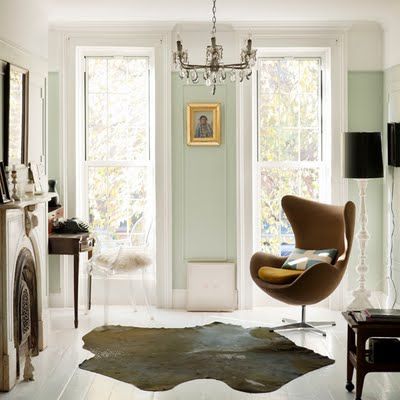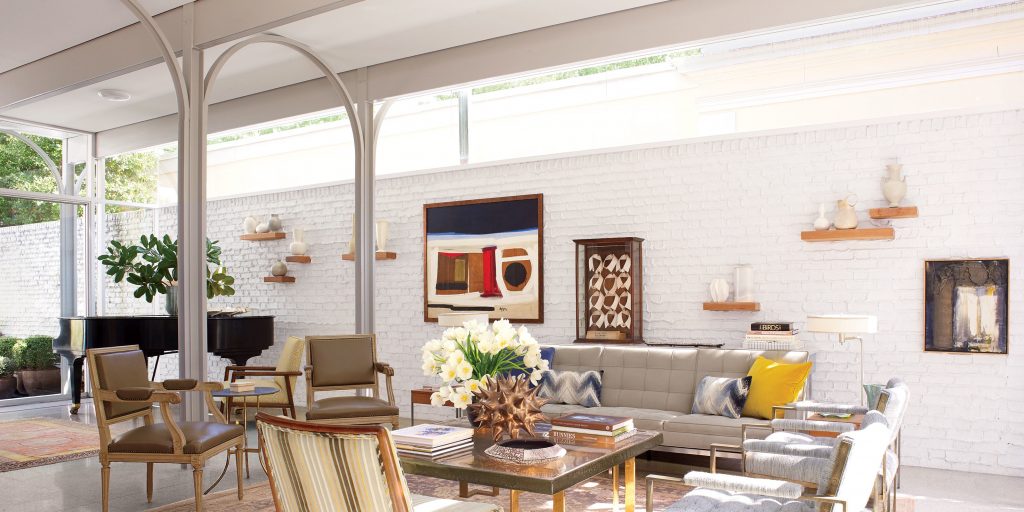
As human beings, we best understand the value of things through comparison. In fact, this is a pretty powerful psychological trigger that you can use for selling your services.
Here’s an example. As a designer working in architecture, you’re aware that where you place the windows has a big dramatic effect on how people perceive the space being dark or light. So for instance, if I have a room and, let’s say, and along one side of the room we have tall, skinny windows that are illuminating the interior.

Now what’s gonna happen is this room is, especially if you’re looking towards the windows, this room is going to appear to be comparatively dark. It’s going to be experienced as a comparatively dark room.
Now if you flip it around, if you’re looking at the wall opposite the windows, the room will seem light. Why is that?
Well, because on the wall opposite the window, we’re not looking straight at something that’s giving off a bright light (i.e. the windows), and contrasting with something that’s not giving off a bright light (i.e. the walls in between the windows). Instead, you’re seeing the sunlight reflected in and scattering around the room.
This concept of comparison is why as architects we love good lighting in a room. We love this idea of clerestory windows, right? This is because we know that clerestory windows don’t create a high-contrast bright spot in the room. What they do is they bounce the light off the ceiling, and they make this beautiful diffused light throughout the room.

If you measure the lumens in the first room, there might actually be more light entering this room with these big windows than in the clerestory example. But again, it’s all about the way we perceive it.
Now, here’s the deal. When someone’s looking at your proposal and you have a lump sum fee or you have whatever the fee comes out to be, let’s just say you’re going to be charging $100,000 for architectural services, and then they’re comparing that against other proposals.
Read: Use This Design Proposal Template to Protect Your Bottomline
Let’s say there’s another firm that’s charging $80,000. What do they see? Suddenly, your proposal seems exponentially more than a hundred-thousand-dollar fee because they’re looking at it compared to another fee.
And it doesn’t matter that the services might be different, or the scopes might be different. We get this conversation, but our clients don’t. So how do we deal with this? How do we win the proposal, even if we’re the expensive one?
One thing we can do is to get away from this outdated pricing model is, we can use an internal pricing model. An internal pricing model is simply the model of giving our clients options. This is something that we see a lot software as a service — SaaS companies do this a lot.
All it means is this idea of having three price options. For example, let’s say you have three pricing levels — you have your gold, silver, and then bronze packages. The silver is a little bit more expensive and the gold is our premium model, right? And then you have a list of services that are included in each of these models.
So this is where we can kind of break down a little bit of scope. We want to make sure that are large buckets. We don’t want to get too detailed. But then we say, okay, the bronze one includes this, this, and this. The silver includes this, this, this, this, this, and the gold includes everything.
Let’s say the bronze is your 80k model, right? Your 100k fee is the silver, and it’s 120k or 150k for the gold. Do you see what we’re doing here? Now it changes the dynamic. If the other firm comes in and says, okay, our fee is 80k, you’ll be able to say, “Okay, cool, we have an 80k model as well.”
Your conversation can go like this: “If you guys want to go with the bronze, we can do that. But we recommend the silver for these reasons.” And then we get into the conversation about value.
The other benefit of creating an internal pricing model where we’re giving them some options within our proposal is this idea of the 80-20 principle. This principle was proposed by the Italian economist Vilfredo Pareto. He did a study of the land ownership in Italy and what he discovered is interesting. He found out that 20% of the land owners owned 80% of the land. And conversely, the remaining 80% — so the large majority of land owners — owned 20% of land.
This is the principle we see where things are heavily weighted on one side — like with the 1%, for example. We see this with economic striation: There are fewer and fewer people that possess more and more resources.
How does this apply to this internal pricing model? Well, it lets you capture a bigger share of the market. Let’s say your proposal just has one option: You’re going to capture fees only at a certain level. However, if you have multiple options, it’s going to bump up your average fee per contract.
And this is how you can instantly make every proposal more profitable without actually doing more work. Right now, you may have expanded scope of services. You’re not going to have to work any harder if they choose the more expensive model, because you’re getting paid for that work as well. So this is how you get more money from every proposal.
Featured image by Peter Henderson, via Folio Illustration Agency.
This post is an excerpt of a webinar and podcast by Enoch Sears, hosted by Fohlio Inc. You can watch the complete webinar with visual aids here, or listen to the complete podcast here:
Subscribe to our podcast here!
Fohlio helps you put together service and job site packages more easily, calculate cost and profit, and deliver more projects in less time. Check out our features here. Schedule a demo here.
Expore Fohlio
Learn how to:
- Save days of work with faster specification
- Create firm-wide design standards
- Automate and centralize procurement
- Keep your whole team on the same Page
- Manage product data
- Track budget against cost in real time.
- Prepare for asset valuation
Published Jun 10, 2019

